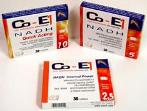CO-E1 NADH - 10 MG - 30 LZ
ENADA® ALERT (NOW CALLED "CO-E1 NADH") by Dr. Birkmayer - Menuco is used for some of the following conditions:
- Fibromyalgia symptoms
- Enhances Energy Naturally!
- Memory
- Chronic Fatigue Syndrome
NADH, biologically known as Coenzyme 1, is the reduced form of nicotinamide adenine dinucleotide (NAD) with high energy hydrogen (H) which provides energy to the cell. NADH plus Chlorophyll is necessary for thousands of biochemical reactions within the body and is found naturally in every living cell. NADH plays a key role in the energy production of cells, particularly in the brain and central nervous system. The more NADH a cell has available, the more energy it can produce to perform its process efficiently.
NADH stimulates cellular production of the neurotransmitters Dopamine, Noradrenaline, and Serotonin, thereby improving mental clarity, alertness and concentration.
ENADA NADH (reduced -nicotinamide adenine dinucleotide) is coenzyme 1, an important cellular energizing coenzyme.
NADH is a coenzyme naturally present in all living cells and is necessary for cellular development and energy production.
ENADA NADH is clinically proven effective for chronic fatigue syndrome. CFS patients taking ENADA are four times more likely to improve than those taking a placebo.
ENADA NADH is being clinically tested at Georgetown University Medical Center for the treatment of Alzheimer's Disease, and in long term CFS studies.
ENADA NADH is not a hormone, not a steroid.
ENADA NADH is a potent antioxidant form of vitamin B-3.
NADH is directly involved in the body's cellular immune defensive system and the more NADH in your body the better the DNA repair system functions.
Keats Publishing, Inc. has published NADH The Energizing Coenzyme, a book authored by Professor George D. Birkmayer, M.D., Ph.D., available at health food stores everywhere.
STUDY ABSTRACT
THE MEASUREMENT OF 5-HIAA URINARY CONCENTRATION AS A POSSIBLE PREDICTIVE MARKER OF DISEASE ACTIVITY AND THERAPEUTIC EFFICACY OF NADH IN THE CHRONIC FATIGUE SYNDROME.
Joseph A Bellanti MD ; Linda M Forsyth MD ; Ana Luiza MacDowell-Carneiro MD ; Dawn B. Wallerstedt, MSN, FNP ; Harry G Preuss MD2 and Georg D Birkmayer MD. PhD3
From the Departments of Pediatrics and Microbiology-Immunology and the International Center for Interdisciplinary Studies of Immunology1 and the Department of Medicine, Division of Nephrology2, Georgetown University Medical Center, Washington, DC; and Birkmayer Pharmaceuticals3, Vienna, Austria.
Background: Chronic fatigue syndrome (CFS) is a disorder of unknown etiology characterized by prolonged, severe fatigue that persists six months or greater in duration and by a multitude of symptoms including neurocognitive dysfunction, flu-like symptoms, myalgia, muscle weakness, arthralgia, low-grade fever, sore throat, headaches sleep disturbances and swelling and tenderness of the lymph nodes. We have recently demonstrated the clinical effectiveness of reduced nicotinamide adenine dinucleotide (NADH) in a group of 26 patients with CFS in a double-blinded, placebo-controlled, crossover study.
Objective: The overall goal of the present study was to extend our initial observations of the clinical efficacy of NADH in CFS to the measurement of a spectrum of biochemical neurotransmitter metabolites which might serve as predictive marker(s) of disease activity. Plasma concentrations of norepinephrine, dopamine and serotonin as well as urinary metabolites, 5-hydroxyindole acetic acid (5-HIAA) and homovanillic acid (HVA) were measured.
Methods: Ten of the originally reported patients with CFS were evaluated. Plasma concentrations of the norepinephrine metabolite MHPG and urinary concentrations of the serotonin and dopamine metabolites, 5-HIAA and HVA, respectively, were measured and the results were analyzed and correlated with treatment of subjects with NADH or placebo.
Results: No significant changes in plasma metabolites were observed. In contrast, baseline values of urinary concentrations of 5-HIAA were elevated (>2mgfL) prior to NADH or placebo in 15/20 (75%) of patient-paired-sample measurements. Following NADH treatment these elevated 5-HIAA concentrations returned to the normal range (<2mg/L) in 7/10(70%) of subjects receiving NADH and in 3/10 (30%) of subjects receiving placebo. The mean negative change in urinary 5-HIAA concentration over the 4 week treatment period was -3.41 in NADH-treated subjects vs. -1.92 in placebo-treated subjects; the mean positive change in urinary 5-HIAA concentration over the 4 week period was +0.17 in the NADH-treated subjects vs. +4.73 in the placebo-treated group (p<0.05).
Conclusions: The results of these preliminary studies not only suggest that NADH is a safe naturally occurring biological substance which may be a useful therapeutic adjunct in the management of the chronic fatigue syndrome, but also that the measurement of urinary 5-HIAA may serve both as an important predictive marker of disease activity as well as an objective marker of improvement following NADH therapy.


